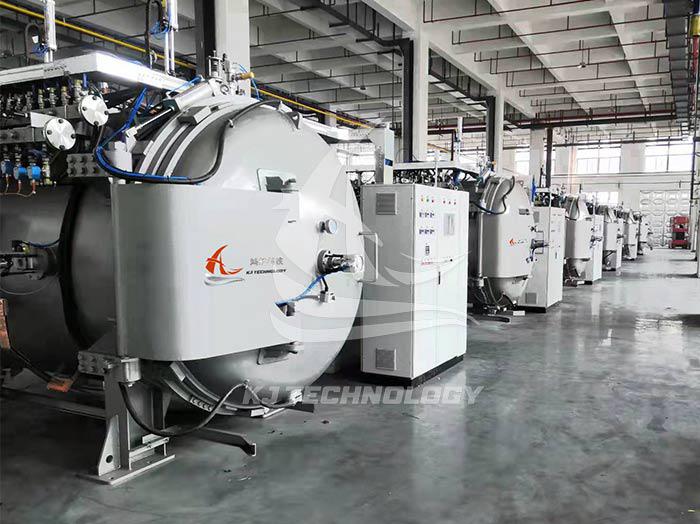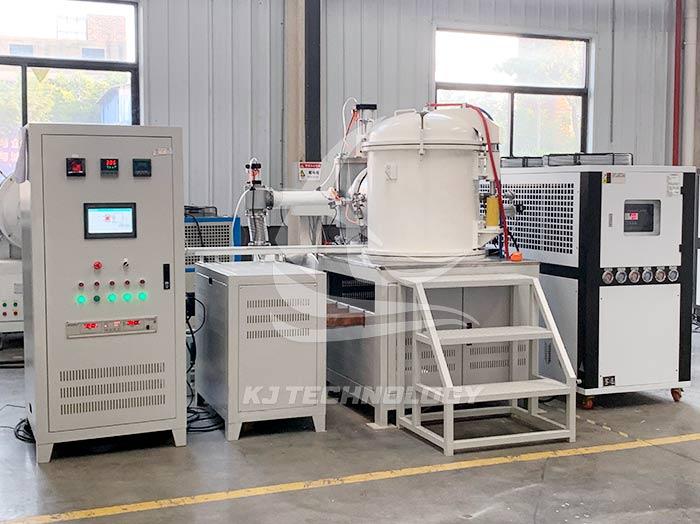Can metal heat treatment furnaces be used for quenching?
 08-12-2025 Author: KJ technology
08-12-2025 Author: KJ technology
Metal heat treatment furnaces can be fully used for quenching processes. Quenching is one of the core processes in metal heat treatment, which involves heating the metal above the critical temperature, holding it for a certain period of time, and then rapidly cooling it (usually in water, oil, or polymer solution) to obtain a high hardness, high strength martensitic or supersaturated solid solution structure. The following is a detailed explanation:
1. Selection of furnace type for quenching process
Box type quenching furnace
Applicable scenarios: Batch processing of small and medium-sized parts (such as gears, shafts, molds, etc.).
characteristic:
Good temperature uniformity (within ± 5 ℃) ensures consistent overall performance of the parts.
Equipped with rapid cooling devices (such as spray systems or built-in cooling tanks), it can achieve integrated operation of "heating insulation quenching".
Example: After heating in an 850 ℃ box furnace, car gears are directly quenched with water through a spray system, and the hardness can reach 58-62 HRC.
Well type quenching furnace
Applicable scenarios: Vertical quenching of long axis and annular parts (such as drive shafts and bearing rings).
characteristic:
Vertical heating design reduces part deformation.
Equipped with quenching oil or water tanks to achieve vertical lifting quenching.
Example: A bearing ring with a diameter of 500mm is heated in an 860 ℃ pit furnace and vertically immersed in a quenching oil tank, achieving a hardness of 60-64 HRC.
Continuous quenching furnace
Applicable scenarios: Large scale production lines (such as continuous quenching of springs, steel wires, and strips).
characteristic:
The parts are continuously transported through the heating zone, insulation zone, and cooling zone via a conveyor belt.
The cooling speed can be precisely controlled (such as water mist cooling, oil cooling combination).
Example: After heating in a continuous furnace at 900 ℃ and quenching with high-pressure water mist, the tensile strength of a car suspension spring can reach over 1600 MPa.
vacuum quenching furnace
Applicable scenarios: high-precision, high surface quality parts (such as aviation blades, mold steel).
characteristic:
Heating in a vacuum environment (to avoid oxidation and decarburization), followed by rapid cooling with high-pressure gas (such as nitrogen).
High surface smoothness and small deformation.
Example: After solid solution treatment in a vacuum furnace at 1150 ℃, the blades of an aircraft engine are quenched with high-pressure nitrogen gas, and the hardness can reach 48-52 HRC, with no oxide scale on the surface.
2. Key parameter control of quenching process
Heating temperature
Principle: It should be higher than the critical temperature of the metal (Ac ∝ or Ac ₁) to ensure complete austenitization.
Example:
Quenching temperature of 45 # steel: 840-860 ℃ (Ac ∝≈ 820 ℃).
T10 steel (tool steel) quenching temperature: 760-780 ℃ (Ac ₁ ≈ 730 ℃).
Holding time
Principle: Calculate based on the effective thickness of the part (usually 15-30 minutes/25mm) to ensure uniform temperature.
Example: For shaft components with a diameter of 100mm, the insulation time should be ≥ 1 hour.
Cooling medium and velocity
Water quenching: The fastest cooling rate (about 200-300 ℃/s), suitable for high carbon steel and alloy steel.
Oil quenching: Moderate cooling rate (about 50-100 ℃/s), suitable for medium carbon steel and mold steel.
Polymer quenching fluid: adjustable cooling rate (controlled by concentration), suitable for complex shaped parts to reduce deformation.
High pressure gas quenching: commonly used in vacuum furnaces, with a cooling rate of 100-200 ℃/s, suitable for stainless steel and high-temperature alloys.
3. Typical microstructure and properties after quenching
Martensitic structure
Formation conditions: After rapid cooling, carbon steel or alloy steel transforms from austenite to high hardness martensite.
Performance: High hardness (50-65 HRC), good wear resistance, but high brittleness, requiring tempering treatment.
bainite
Formation conditions: Medium carbon steel is formed after isothermal quenching (such as insulation at 250-350 ℃ in a salt bath furnace).
Performance: Moderate hardness (40-50 HRC), better toughness than martensite, suitable for impact load parts.
supersaturated solid solution
Formation conditions: Aluminum alloy and titanium alloy are formed after solid solution treatment and water quenching.
Performance: The strength is significantly improved (such as the tensile strength of 2A12 aluminum alloy reaching 490 MPa or more), and further strengthening is required through aging treatment.
4. Precautions for quenching process
Prevent cracking:
Avoid excessive temperature gradients in the cross-section of the parts (such as cracking in areas with uneven thickness).
Pre cool to a temperature below Ar ∝ and then quench (such as using the "pre cooling quenching" process for large forgings).
Control deformation:
Adopting graded quenching (such as first water cooling below the Ms point, and then oil cooling).
Use pressure quenching molds (apply pressure to thin-walled parts to reduce deformation).
Surface quality:
Vacuum quenching can avoid oxidation and decarburization, and the surface roughness can reach Ra0.8 μ m or less.
Salt bath quenching requires subsequent cleaning to remove residual salt.








